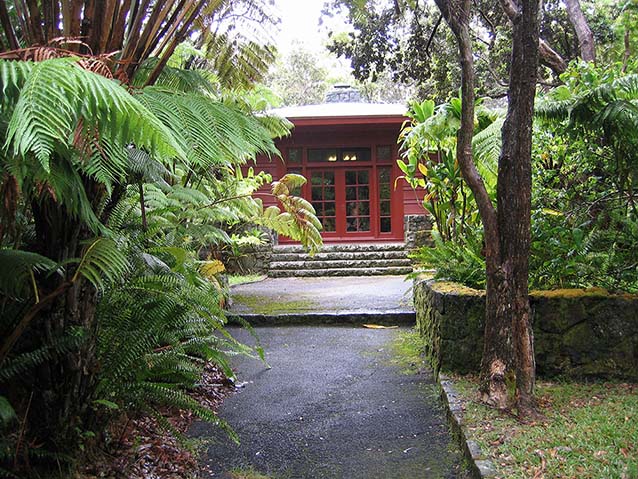The Kilauea Administration and Employee Housing Historic District is located along Crater Rim Drive, approximately one quarter-mile west of the Hilo entrance station of Hawaii Volcanoes National Park. The district is historically significant for the period 1927 to 1942 for its association with early park planning, the Civilian Conservation Corps, and the embodiment of distinctive characteristics of the Rustic Style.
Spare no expense, but keep it simple. Tomas C. Vint, Chief of the Park Service Branch of Plans and Designs

NPS

NPS
The period of significance for the Kilauea Administration and Employee Housing Historic District (or, Kilauea headquarters) extends from 1927 to 1942. This time frame encompasses the period of initial development of the park and ends with the closing of the Civilian Conservation Corps (CCC) program when the United States entered into World War II. This historic district is significant at the state level for its association with early park planning and for its association with the CCC. It also embodies distinctive characteristics of the NPS Rustic Style as expressed during the early development of Hawaii Volcanoes National Park.
The Kilauea headquarters includes a picturesque collection of small-scale, rustic-styled houses and buildings massed along the northeast edge of Kilauea Caldera. Most of the existing structures were sited according to a series of master plans developed from 1931 to 1941 by the Landscape and Engineering Division of the National Park Service. Most of the buildings and landscape features were built by CCC crews during this same era.

NPS
The National Park Service Western Region Branch of Plans and Design (the successor to the Landscape Engineering Division) completed a comprehensive plan for the headquarters area in the mid-1930s during the period of intensive development at Hawaii Volcanoes National Park. The rustic-style buildings and structures were designed using an adapted Hawaiian style of building that incorporated tropical design elements, such as wider eaves and larger windows, that were responsive to the wetter but warmer conditions of the Hawaiian Islands. Both the structures and the landscape were developed following naturalistic principles that advocated the use of native materials and plants. Wood siding was stained or painted grey to blend with the ohia forest; and lava rock design elements such as walkways, planters, and foundation veneers helped harmonize the built environment with the natural.
Today, the headquarters area remains the main administrative and residential area for Hawaii Volcanoes National Park, and landscape characteristics such as spatial organization, cluster arrangement, topography, buildings and structures, circulation, small-scale features, and native vegetation contribute to the historic district’s integrity including its setting. Most of the structures that currently exist in the Kilauea Administration and Employee Housing Historic District had been built by the end of the Mission 66 development, with the majority of these built before World War II. A few have been added, including the 1968 Ranger Office, the 1974 concessionaire dormitory, the Kilauea Visitor Center comfort station, the 1992 fire house, and the 2000 washrack.

NPS
Quick Facts
- Cultural Landscape Type: Designed
- National Register Significance Level: Local
- National Register Significance Criteria: A, C
- World Heritage Site
- Period of Significance: 1927 - 1942
Landscape Links
Last updated: December 27, 2019
